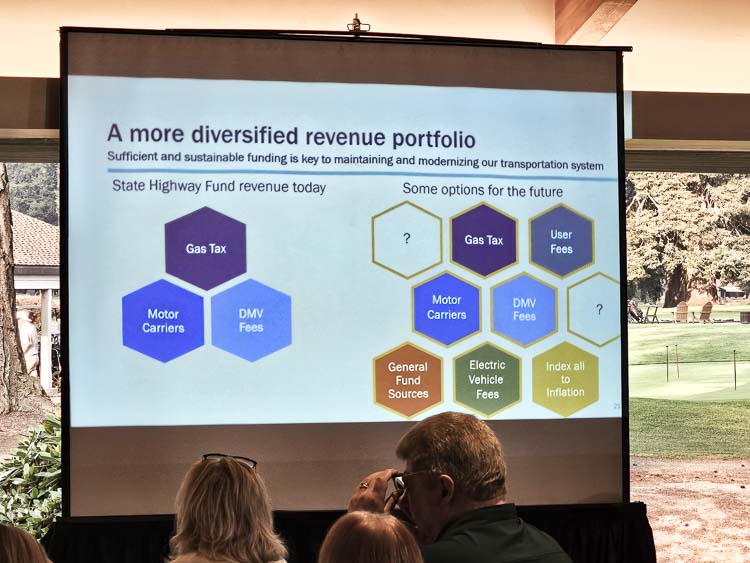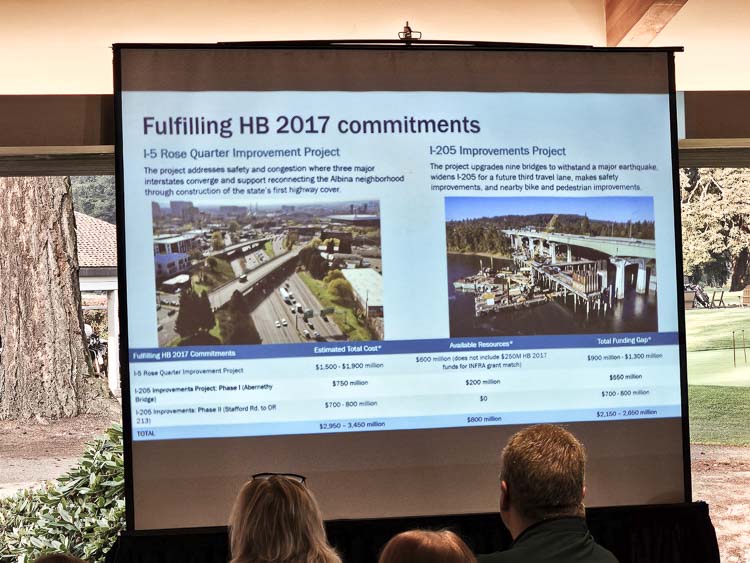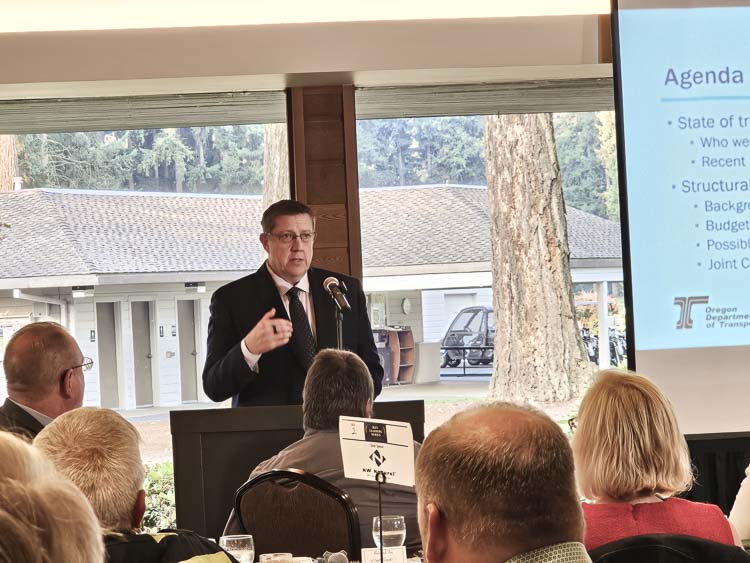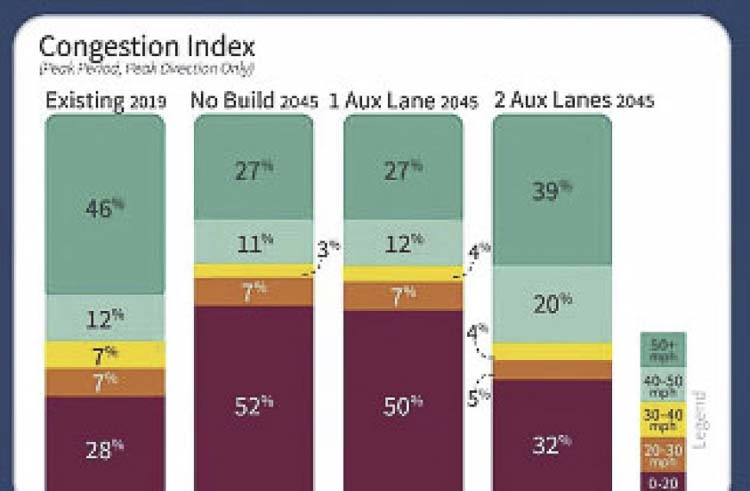
Oregon lawmaker defends replacing three-lane bridge I-5 Bridge with three-lane bridge
John Ley
For Clark County Today
Officials of the Oregon Department of Transportation (ODOT) and members of the Oregon legislature have been touring the state, talking about a “structural revenue challenge” and the need to raise taxes to fund transportation. An ODOT video pitch mentions a “permanent decline” in revenue.
Kris Strickler, ODOT director, and Rep. Susan McLain recently attended a Tualatin Chamber gathering. Strickler told the community they have a $1.7 billion revenue shortfall each year. That doesn’t include a $2 billion to $3 billion shortfall on HB 2017 projects, including the I-5 Rose Quarter project and two phases of the I-205 Abernethy Bridge project.
The $5.3 billion transportation package now appears to be costing at least $8 billion. At the time it included “historic” investments in transit. That didn’t include at least $1 billion funding for the Interstate Bridge Replacement project.
This is of vital interest to Southwest Washington citizens, as 71,550 Clark County residents paid $250 million in 2022 Oregon income taxes to commute to work. Another 47,630 Washington residents paid an additional $175.5 million, according to the Oregon treasurer. McLain is also a member of the Bi-state Bridge Committee of 16 legislators providing oversight to the Interstate Bridge Replacement Program (IBR) and a strong proponent of both tolling and extending light rail into Clark County.

Oregon has promised a $1 billion contribution to the I-5 Bridge replacement project, yet has only funded $250 million. Gov. Tina Kotek has objected to the legislature using promised general fund tax revenue for the state’s contribution to the $7.5 billion project. Where will the remaining $750 million come from?
When Kotek “paused” I-5 and I-205 tolling earlier this year, the governor demanded the legislature come up with a broader transportation package in 2025. She did allow for tolling to proceed on the I-5 Bridge replacement project. She did not preclude tolling other roads from being a part of a larger tax package the legislature considers.
Strickler and McLain mentioned current transportation funding is a “three-legged stool” of gas taxes, car registration fees, and weight-mile fees paid by freight haulers. “We need more than a three-legged stool,” Strickler said, showing a graphic with nine legs for possibly taxing the people.
One was allowing an automatic increase in the gas tax and other fees, based upon inflation. Another person mentioned a 12-legged stool for funding. A road user charge was emphasized.
The two were heavily pushing the need for maintenance dollars, a responsibility of the legislature that apparently only allocated 3 percent of HB 2017 to maintenance. The new taxes “can’t happen after 2025,” McLain said. ODOT’s total annual budget is about $6.3 billion.
She mentioned user fees and/or tolls, as mid-term possible solutions for the funding problems. But the pair were pushing for more legs for the funding stool. Whatever means they can get the public to accept paying more money for transportation, as soon as possible.
There was no mention of the fact that ODOT created the first part of the HB 2017 funding hole, by failing to include inflation in the numbers they told the legislature seven years ago. They also failed to mention that it was politicians who have made political promises to the Albina Neighborhood to create real estate at the Rose Quarter via a roughly $1 billion lid over the freeway.
The Rose Quarter project cost has jumped four-fold, from $450 million to nearly $2 billion. The I-205 Abernethy Bridge has jumped from $450 million to roughly $1.5 billion, with the seven-mile addition of a third lane being added to I-205 between the bridge and Stafford Road now on hold. The added vehicle capacity was going to eliminate 12 hours of I-205 traffic congestion, according to ODOT.
Multiple citizen comments at the chamber event expressed concerns about tolling as a source of new transportation dollars. Nearly a year ago, West Linn Mayor Rory Bialostosky revealed the ODOT plan to toll I-205 had an 83-86 percent cost of collection. That triggered huge outrage as Clackamas County residents pushed back against traffic diversion and the ridiculous collection costs as reasons to kill tolling.
But one elected official (female), spoke about “all those people from Vancouver” who will divert to I-205, saying they won’t pay their fair share. The IBR team has not released updated data on traffic diversion due to tolling the I-5 Bridge. In the failed Columbia River Crossing, it was estimated 35,000 vehicles would divert and use I-205, adding to the traffic congestion on the I-205 Glenn Jackson Bridge. Strickler responded noting the Washington legislature has prohibited tolling the I-205 bridge.

Strickler mentioned “a lot of wins” for Oregon, referencing huge federal funding for projects like the Rose Quarter and the I-5 Bridge replacement. “One time money that comes in is fantastic,” he said. However he indicated none of the billions in recent federal funding can be used for day-to-day operations and maintenance. “Only 3 percent of the funding that came in under House Bill 2017 was dedicated to operations and maintenance,” he said.
Citizen questions and comments included Dave Farmer from West Linn. “We need our third lane,” on I-205 from Stafford Road to the Abernethy Bridge. Lack of funding via tolls, was blamed for stopping the added seven-mile lane.
Clark County Today asked: “The Portland metro area has the nation’s 12th worst traffic congestion, and we seem to be getting worse. The I-5 Bridge project is $7.5 billion and is going to replace a three-lane bridge with another three-lane bridge. It will be congested on day one when it opens. Where’s the value in spending the largest amount of money in the history of Oregon and Washington on something like this, that is, replacing an over-congested bridge with another over-congested bridge?”
McLain said she was happy to respond.
“First of all, what a nice question for this morning. It’s an important one, and I’ve been working for seven years on that. And you know, that project and in my estimation, I don’t basically interpret it the way you have. I’m going to talk about why, first of all, we’re doing really well with federal grants for that project because of the importance of that bridge to the West Coast, not just Oregon, but for the West Coast and our economic conditions on the West Coast.
“Number two, it is the most congested bridge, and it is a stoplight bridge because we have a bridge that opens up and it has been noted (to be) in the top 30 most congested places in the United States. So should we just leave the status quo? I don’t think so.
“So now let’s talk about the designs. We know that there’s at least four designs that are being reviewed for the environmental review that we have to do for the federal government’s process, and that’s going quite well. There are a lot of conditions on that bridge. I’m just going to name one. And that is the fact that there is no safety, you know, there’s no safety shoulders, there are no safety shoulders. So not only is it not good for bikes and ped (pedestrian). We can’t even get our emergency vehicles across.
“All of those designs have shoulders. All of those designs have bike and ped; all of those designs have the ability to have auxiliary lanes and get people off the seven different exits and entrances along a very small piece of space, like three to five miles. And we can do that easier with those auxiliary lanes. And we are also able then to clean out the middle for the freight and other types of business that we need to get to our ports.
“So we may not agree sir on the type of design it’s going to be finished on; but I will tell you right now that it’s going to be safer, it’s going to be less congested, and it’s going to actually be very functional. And it’s going to be functional in a way when we get the Rose Quarter along with it, to actually do some differences between what we’ve experienced in the last 15, 20 years and what we will experience in the future.”
Yet the data released so far, contradicts McLain. The IBR indicates that in 2045, half of rush hour traffic will be traveling zero to 20 mph. Furthermore, the program reports that morning travel times from Salmon Creek to the Fremont Bridge will more than double, from 29 minutes today to at least 60 minutes. This supposedly is after Oregon completes the Rose Quarter project.

Strickler weighed in as well, talking about the increased capacity for transit, bike lanes and pedestrian facilities. “We know that the transit use across the bridge is very limited,” he said.
“The amount of increased capacity that comes with that is actually pretty significant,” he said. “It’s just sort of more modes than it’s able to serve today. I think that’s an important factor, not just for the day-to-day trips, but also for the economy.”
The fact that the IBR is allocating 54 percent of the bridge surface to transit, bikes, and pedestrians wasn’t mentioned. That’s up from 11 percent today. The space for cars and freight haulers declines to just 46 percent, less than half of the proposed new bridge.
An additional issue not brought up, is that IBR Administrator Greg Johnson told Bi-State Legislators last December, that the cost of the project would be going up. In June, he shared an updated cost estimate would not be revealed until “this time next year,” the summer of 2025.
A Q&A moderator mentioned that the addition of a new auxiliary lane connecting OR 217 to I-205 had eliminated several hours of I-5 traffic congestion. ODOT was projecting a 12-hour reduction in traffic congestion on I-205 by 2045 after they added a new lane in each direction to I-205 as part of their Abernethy Bridge project.
McLain shared that Oregon legislators are currently focused on three areas for funding. Operations and maintenance is number one, because it relates to safety. Number two, transit and anything that is micro-mobility. That means scooters and electric bikes and walking and safe routes to school and everything else.
“The third group is going to be finishing our commitments,” she said. It will be a very short list of anchor projects that are important. McLain said “we’re doing very well getting federal funds for those anchor projects that we want to finish,” especially the Rose Quarter and Abernethy Bridge.
Nowhere was there mention of adding new transportation corridors or major efforts that will actually reduce traffic congestion. Besides safety, saving time is the top priority of people dealing with the nation’s 12th worst traffic congestion.
Furthermore, there was no mention of cutting back on transit spending. This is in spite of the “new normal” of reduced transit ridership and more people working from home. The Regional Transportation Council (RTC) reported this in May. Surely Oregon is aware of this “new normal.”
Also read:
- Expect delays on eastbound SR 14 for safety repairs, April 2Expect delays April 2 on eastbound SR 14 for guardrail repairs near Camas.
- Belkot files suit against Clark County, alleging civil rights violations, breaches to open meeting lawsClark County Councilor Michelle Belkot claims she was removed from the C-TRAN Board of Directors after she intended to vote to protect taxpayers Clark County Councilor Michelle Belkot filed a lawsuit in Skamania County Superior Court against Clark County on Friday, citing violations of the Civil Rights Act, Open Public Meetings Act, and Quo Warranto …
- Clark County hosting April 10 open house about the Northeast Delfel Road realignment projectClark County to host April 10 open house on Delfel Road project, replacing signals with a roundabout.
- Expect delays in both directions of I-5 near Woodland, for safety improvements, April 1-3WSDOT will close I-5 lanes near Woodland April 1–3 for cable barrier repairs and debris removal.
- Letter: ‘Thank you Michelle Belkot for your courage to question the light rail need and its prohibitive costs’Vancouver resident praises Michelle Belkot for opposing light rail costs and urges ethical governance on transportation boards.









